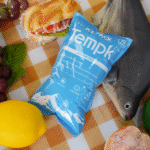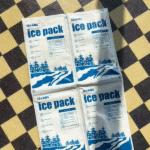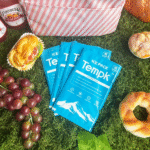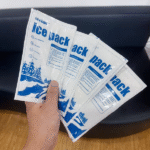Packs de glace sèche Publix: Où acheter, Paquet & Bateau?
Si vous avez besoin packs de glace carbonique Publix aujourd'hui, vérifiez les congélateurs à l’avant du magasin ou le service client, confirmer le stock par téléphone, et prévoir une glacière ventilée pour le transport. Pour une expédition en 2025, marque UN1845, montrer masse de glace sèche nette, Et continuez à emballage. Ce guide fusionne et met à niveau vos trois brouillons en un seul expert, Article optimisé pour le référencement.
-
Où acheter aujourd'hui: placement de magasin, fourchette de prix, et conseils de timing
-
Comment emballer pendant 24 à 72 heures: des mises en page plus cool qui fonctionnent tout simplement
-
Comment expédier correctement 2025: étiquettes, limites, et contrôles d'acceptation
-
Glace sèche ou packs de gel: quand les utiliser et quand les mélanger
-
Des signaux de sécurité importants: Co₂, gants, et ventilation
Où pouvez-vous trouver des packs de glace carbonique Publix près de chez vous?
Réponse courte: Recherchez les congélateurs de marque Penguin près de l’entrée ou de l’allée des produits surgelés.. Demandez au service client de peser les blocs à la livre. Le stock varie selon la saison et l'emplacement, alors appelle à l'avance avant de conduire. Les prix typiques en magasin varient de environ 1,50 $ à 2,50 $ la livre, avec une demande plus élevée pendant les week-ends chauds et les jours fériés. Apportez une glacière dure ventilée pour un transport en toute sécurité.
Pourquoi cela fonctionne pour vous: La glace carbonique est souvent placée à l'avant pour un ramassage rapide pendant les heures de forte demande. Les magasins des zones de villégiature et adjacents à la plage se réapprovisionnent plus fréquemment. Appeler vous évite un voyage inutile, surtout si vous avez besoin de pellets au lieu de blocs. Si un magasin est fermé, élargissez votre rayon de 5 à 10 miles et essayez un deuxième Publix.
Emplacement en magasin et guide rapide des prix
| Que chercher | Endroit typique | Indice de prix | Ce que cela signifie pour vous |
|---|---|---|---|
| Présentoir de marque Penguin | Zone d’entrée ou de caisse | ~1,50 $ à 2,50 $/lb | Budget rapide; demander au personnel de peser les blocs |
| Comptoir du service client | À l'avant | Posté ou verbal | Idéal pour les coupes/quantités spéciales |
| Embout d'allée gelée | Près de la glace | Même gamme | Emplacement de sauvegarde fiable |
Des conseils pratiques pour gagner du temps
-
Appelez d'abord: Demandez « Avez-vous packs de glace carbonique Publix en stock en ce moment?»
-
Ramasser en dernier: Achetez de la glace carbonique après le paiement à l'épicerie pour minimiser les pertes.
-
Apportez un séparateur: Un carton ou un plateau rigide maintient les aliments hors de la glace.
Cas réel: Un voyageur du week-end a téléphoné à deux magasins à proximité, j'ai trouvé du stock dans le magasin B, et acheté 6 blocs de livres. Avec une glacière rigide et une étagère en carton, la glace a duré tout le voyage de 36 heures à la plage avec des friandises glacées encore solides au retour.
Comment emballer les glacières avec des packs de glace carbonique Publix pendant 24 à 72 heures?
Configuration de base: Chargez de la glace carbonique par le haut au-dessus de vos articles avec un séparateur rigide. Remplissez l'espace vide avec des serviettes ou du papier pour réduire les fuites d'air chaud. Attendre ~2 à 4 lb par jour pour une glacière de taille moyenne; ajoutez 20 à 30 % si vous l'ouvrez souvent ou si vous vous garez dans une voiture chaude. Cette disposition maximise le temps de maintien sans dommages dus au gel.
Facilitez-vous les choses: La chaleur s'infiltre par les interstices du couvercle et l'espace libre. Les blocs plus gros se subliment plus lentement que les pellets, rythme de négociation pour la longévité. Si vous expédiez en mousse EPS, envisager de passer aux doublures EPP ou VIP pour réduire la masse requise. Validez une fois avec un thermomètre pas cher; puis répliquez cette configuration à chaque fois.
Estimateur rapide & forfait (copier / coller)
| Durée du voyage | Type de refroidisseur | Est. glace carbonique | Pour de meilleurs résultats |
|---|---|---|---|
| 24–36 h | Mousse EPS | 4.4–5,0 livres | Remplir l'espace libre; ouvrir avec parcimonie |
| 36–48 h | Refroidisseur dur EPP | 4.0–4,7 livres | Utilisez un séparateur ou un plateau rigide |
| 48–72 h | Hybride VIP | 4.0–6,0 livres | Préférez les blocs aux pellets |
Conseils testés sur le terrain
-
Chargement par le haut uniquement: Puits de CO₂ froid; garder les blocs au-dessus du produit.
-
Gardez-le aéré: Couvercle fermé, pas enregistré. Évitez les poubelles hermétiques.
-
Étiquetez la glacière: «Glace carbonique - Ventilez avant l'ouverture.»
Exemple réel: Une glacière EPP de 45 pintes avec 5 des blocs de livres et une étagère en carton gardaient les repas surgelés solides pendant 48 heures; Il reste environ 1 lb au déchargement.
Pouvez-vous expédier avec des packs de glace carbonique Publix sous 2025 règles?
Oui, si vous suivez les listes de contrôle. Les expéditions aériennes nécessitent un emballage ventilé et le « Glace sèche » ou « Dioxyde de carbone », solide" + UN1845 marquer avec masse de glace sèche nette (kg) sur la boîte extérieure. De nombreux opérateurs utilisent des listes de contrôle d'acceptation. L'air domestique USPS couvre la glace carbonique à ≤5 lb par envoi postal. Pour le terrain, garder les colis aérés et marqués selon 49 CFR.
Pourquoi ça compte: La plupart des contre-rejets proviennent de kg nets manquants ou de marques de danger masquées. Les évents fermés avec du ruban adhésif ou les doublures entièrement scellées sont des signaux d'alarme. Écrivez clairement, laisser les étiquettes dégagées, et garder les adresses visibles.
Packs de glace sèche Publix vs packs de gel: qui devez-vous utiliser?
Règle: Utilisez de la glace carbonique pour les produits « à rester congelés »,» utiliser des packs de gel pour 2–8 ° C. La glace carbonique entraîne des températures ultra froides pendant des jours et ne laisse aucune eau de fonte. Les packs de gel sont réutilisables, moins cher par course, et parfait pour les charges utiles réfrigérées. De nombreux expéditeurs combinent les deux dans une seule boîte.
De votre point de vue: Articles sensibles à la congélation (Par exemple, baies, quelques pâtisseries) n'aime pas le contact direct avec la neige carbonique. Ajoutez un séparateur ou déplacez ces éléments vers des zones de pack de gel. Pour les longs voyages, faire couler de la neige carbonique sur une couche de PCM ou de gel pour stabiliser les températures.
Des packs hybrides qui fonctionnent tout simplement
| Charge utile & voie | Meilleur choix | Pourquoi ça gagne | Votre action |
|---|---|---|---|
| Glace, 48 h, été | Packs de glace carbonique Publix | Froid profond; tenue la plus longue | Blocs de charge supérieure; diviseur rigide |
| Glacière familiale mixte | Hybride (PCM + glace carbonique) | Profil lisse; moins de pointes | PCM autour de l'alimentation; glace sèche au-dessus |
| Médicaments à 2–8°C, 24 h | Gel/PCM | Bande serrée; aucun risque de gel | Préconditionner le PCM à 2–8°C |
Bases de sécurité et outil rapide pour les packs de glace carbonique Publix
Respectez le CO₂ et le froid extrême. Aérer les voitures et les pièces, porter des gants ou des pinces, et éloignez les enfants et les animaux domestiques. Les limites d'exposition sur le lieu de travail citent souvent 5,000 ppm twa et ~30 000 ppm STEL; les symptômes augmentent rapidement dans les espaces clos. Ne stockez jamais de la glace sèche dans des conteneurs scellés.
Liste de contrôle prête à copier pour vous:
-
Transport dans un refroidisseur dur ventilé; fissurer les vitres de la voiture.
-
Ne pas enregistrer chaque couture; garder les évents dégagés.
-
Utiliser un diviseur rigide pour prévenir les engelures sur les aliments.
-
Publier un « CO₂ présent » noter où le personnel met en scène les glacières.
2025 mises à jour en matière de refroidissement et d'étiquetage de la chaîne du froid
Quoi de neuf: Dans 2025, les listes de contrôle pour la glace carbonique des opérateurs sont plus claires, et les fenêtres d'acceptation sont plus rapides—si tu montres UN1845 et Kg net lisiblement et garder les colis aérés. L'USPS poursuit le ≤5 livres chapeau d'air domestique. La demande de glace carbonique reste saisonnière, avec un pic en été et autour d'Halloween. Vous verrez également davantage de paquebots VIP et de PCM à -20 °C dans les voies « adjacentes au gel »..
Dernier progrès en un coup d'œil
-
Une conformité plus propre: Les listes de contrôle mises à jour réduisent les délais de comptage lorsque les notes sont correctes.
-
Le refroidissement hybride se développe: De plus en plus d'expéditeurs mélangent de la glace carbonique avec du PCM pour lisser les températures et réduire les coûts..
-
Surveillance intelligente: Des enregistreurs à faible coût simplifient la validation des voies, pas spécial.
Perspicacité du marché: Le commerce électronique des produits alimentaires et la logistique liée à la canicule occupent les voies gelées. Les détaillants récompensent les fournisseurs qui arrivent à temps et à portée. Emballage réutilisable, des matériaux plus verts, et la planification d'itinéraires qui évite le reglaçage sont désormais des leviers de coûts standards.
Questions fréquemment posées
Est-ce que chaque Publix transporte des packs de glace carbonique?
Non. La disponibilité varie selon le magasin et la saison. Appelez le service client pour confirmer avant de partir.
Où se trouvent généralement les packs de glace carbonique Publix?
Près de l'entrée ou de la caisse dans un congélateur de marque Penguin, ou au Service Client.
De quelle quantité de neige carbonique ai-je besoin pour un week-end?
Commencer par ~2 à 4 lb par jour pour une glacière de taille moyenne; ajoutez 20 à 30 % pour les voitures chaudes ou les ouvertures fréquentes.
Puis-je expédier de la nourriture avec de la neige carbonique 2025?
Oui. Utiliser un emballage ventilé, marque UN1845, et montrer Kg net. USPS air permet ≤5 livres par courrier.
Glace sèche ou packs de gel : quand choisir lequel ??
Prendre glace carbonique pour les produits véritablement surgelés ou les voies au-dessus 24 h. Prendre gel / pcm pour les articles 2–8°C.
Résumé & recommandations
Points clés: On trouve généralement packs de glace carbonique Publix près des congélateurs avant. Pour les glacières, blocs à chargement par le haut au-dessus d'un diviseur et d'un budget ~2 à 4 lb/jour. Pour expédition, 2025 les règles ont besoin emballage ventilé, UN1845, et Kg net; L'air intérieur USPS reste à ≤5 livres. Aérer les voitures et les pièces, et manipuler avec des gants.
Vos prochaines étapes (CTA):
-
Appelez votre Publix le plus proche pour confirmer le stock aujourd'hui.
-
Emballé avec un séparateur rigide et chargez la neige carbonique par le haut.
-
Si l'expédition, imprimez le bloc d'étiquettes ci-dessus et vérifiez les évents.
-
Benchmark d'une voie de test avec un enregistreur de température, puis standardiser.
À propos du tempk
Nous concevons simplement, des manuels fiables sur la chaîne du froid pour les détaillants, expédiés, et les ménages. Nos directives en matière d'emballage s'alignent sur 2025 listes de contrôle d'acceptation et États-Unis. règles de transport, vous aidant à éviter les rejets et la détérioration. Nous soutenons les conseils avec des tests de voie, calculatrices pratiques, et des SOP reproductibles pour que vous puissiez faire vos valises une seule fois et vous détendre.
Besoin d'une SOP sur mesure ou d'un modèle d'étiquette rapide? Contactez notre équipe pour un examen gratuit de 15 minutes de votre configuration de couloir et de glacière..
























